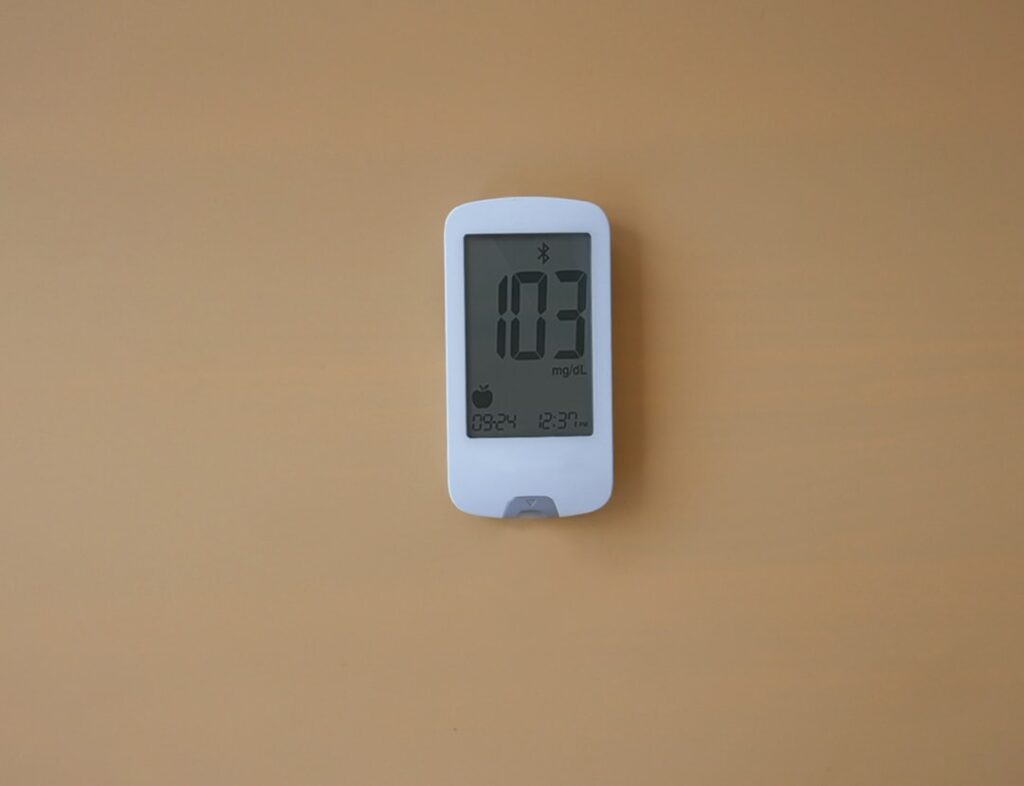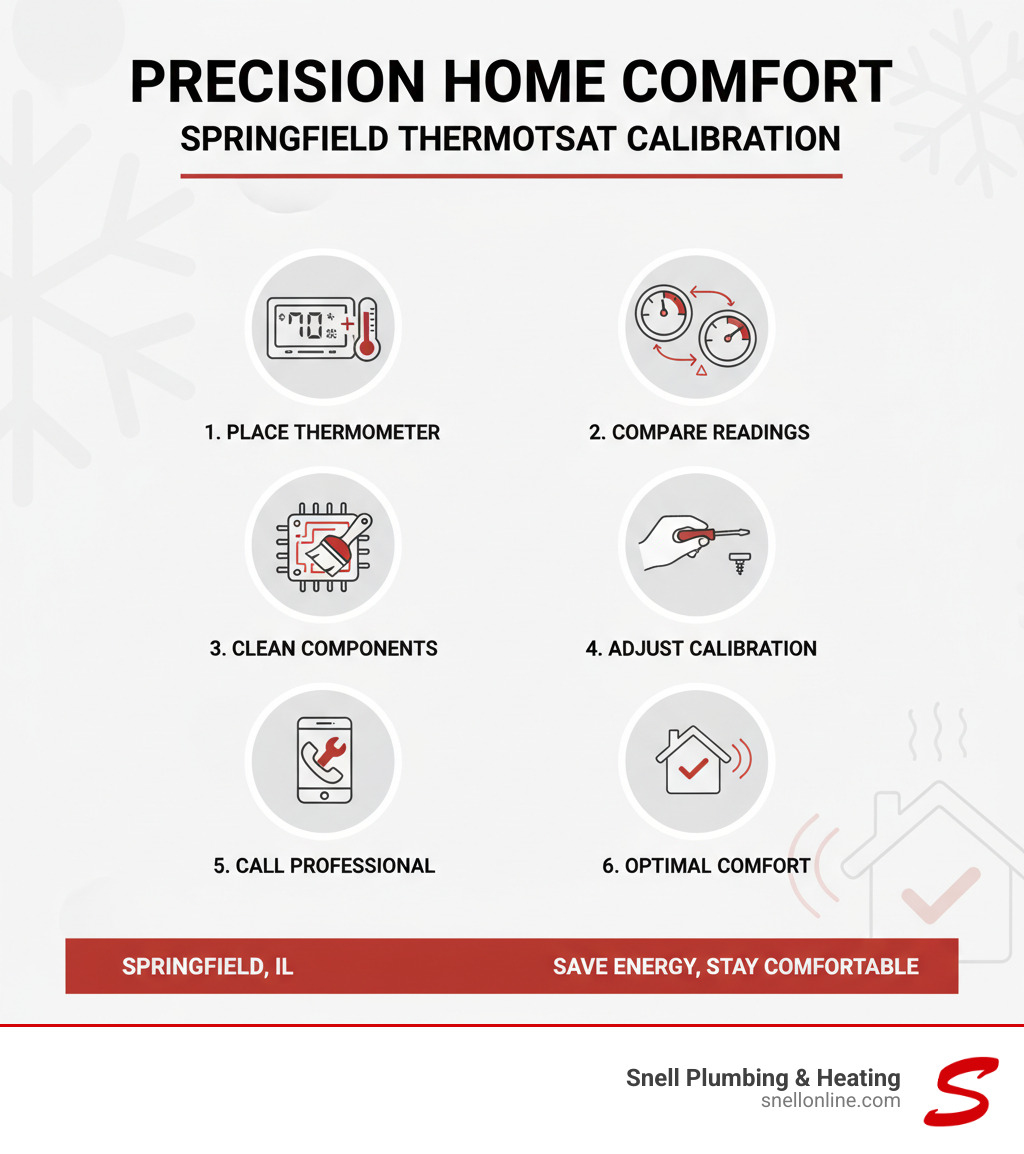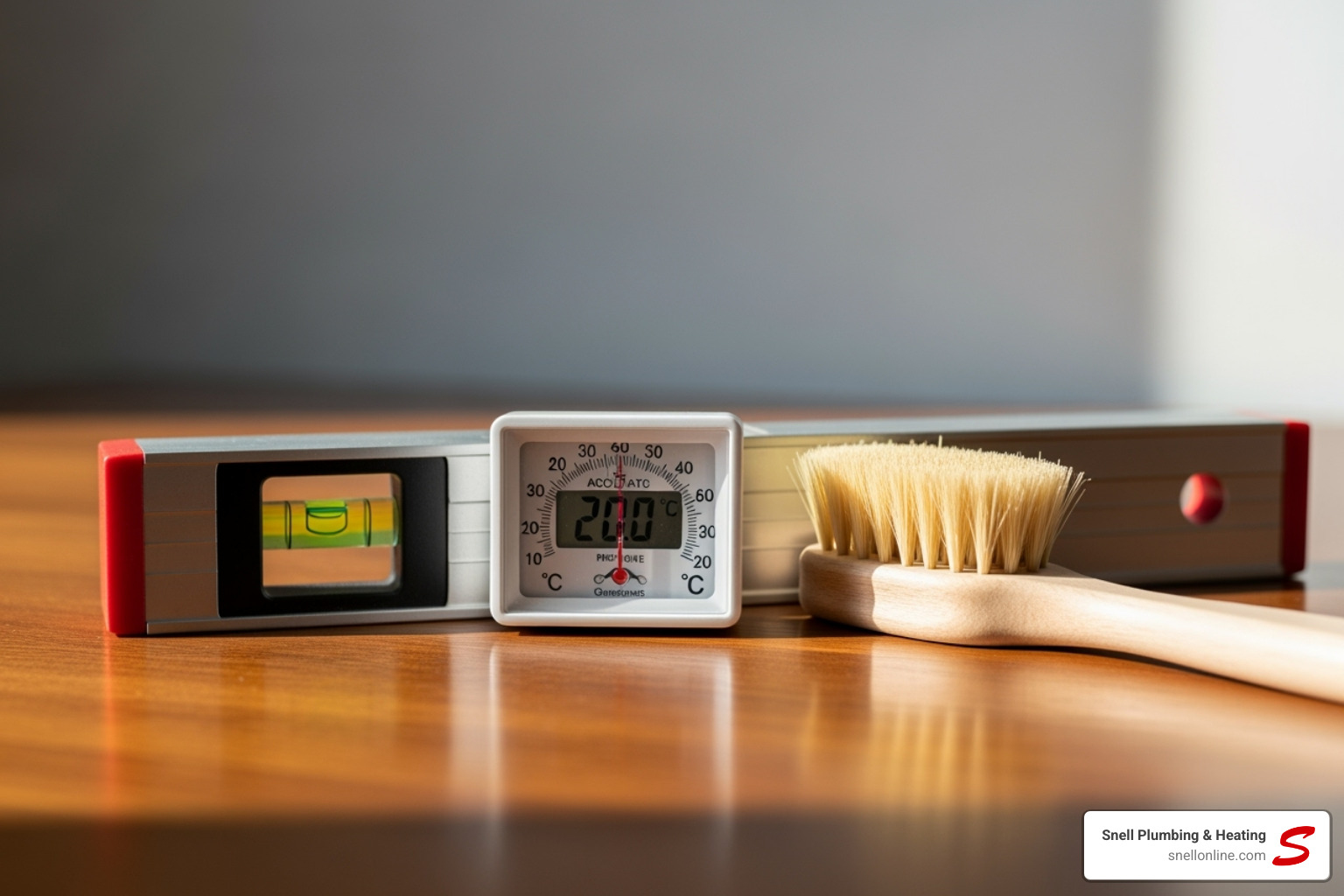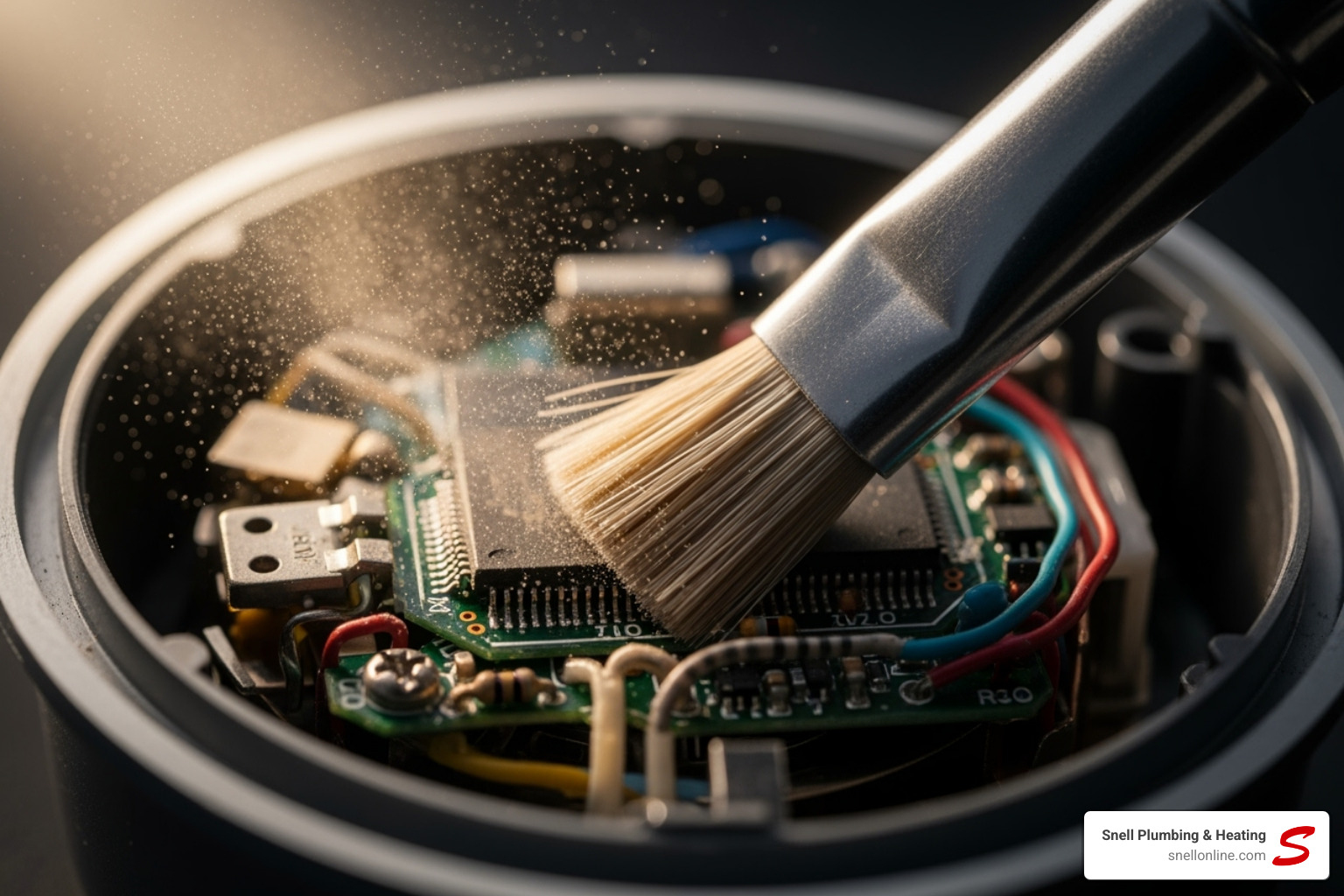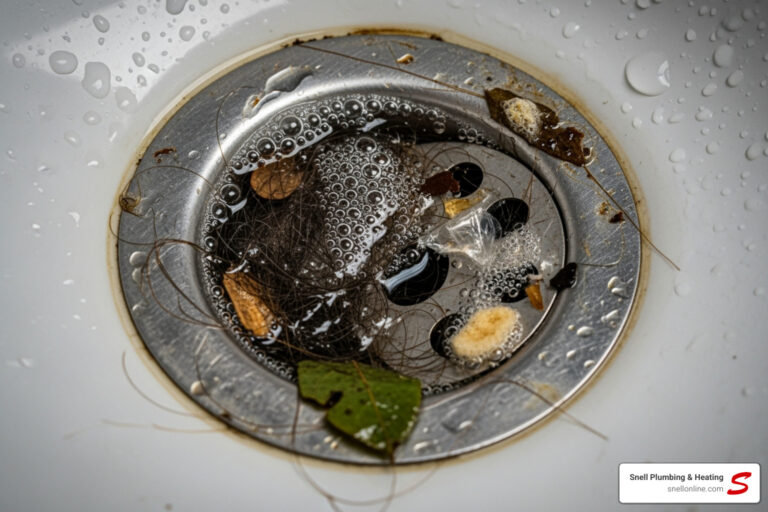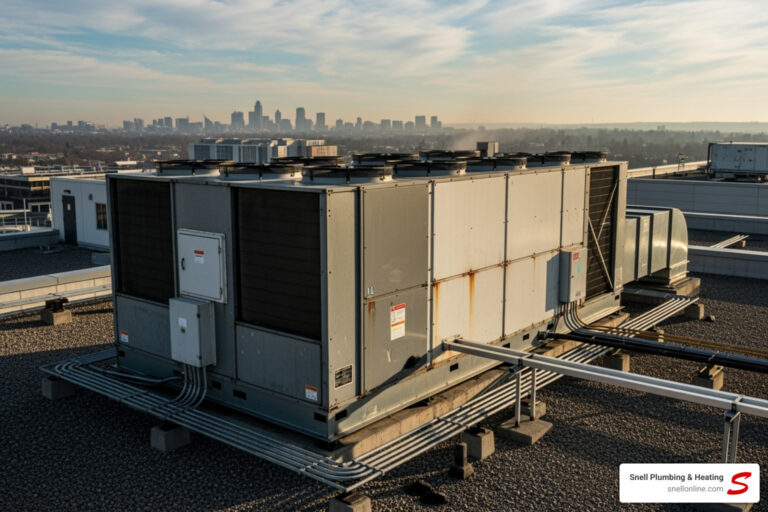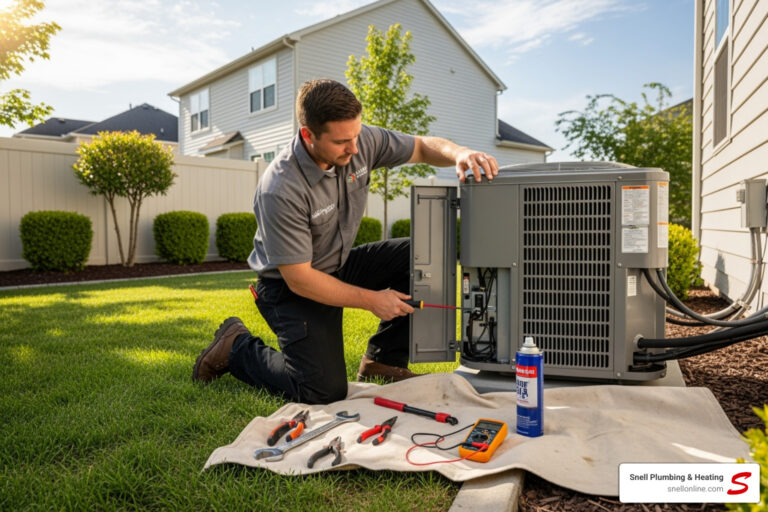Why Thermostat Calibration Matters for Springfield Homeowners
Check thermostat calibration springfield residents need to know – your thermostat acts as the brain of your HVAC system, and when it’s not reading temperatures correctly, your home comfort and energy bills suffer.
Quick Calibration Check Steps:
- Place a reliable thermometer next to your thermostat
- Wait 15-20 minutes for accurate readings
- Compare the readings – differences over 2-3°F indicate calibration issues
- Clean internal components with a soft brush if needed
- Adjust calibration screw following manufacturer instructions
- Call a professional for persistent issues or complex systems
Springfield’s climate puts unique demands on your HVAC system. From sweltering summers that push your air conditioner to its limits to bitter winters that test your heating system, a well-calibrated thermostat is essential for maintaining comfort and controlling energy costs.
When your thermostat misreads your home’s temperature, it creates a cascade of problems. Your HVAC system runs longer than necessary, driving up utility bills and causing unnecessary wear on expensive equipment. You’ll notice inconsistent temperatures between rooms, frequent system cycling, and that frustrating feeling when your home never quite reaches the comfort level you’ve set.
Regular calibration checks help you catch these issues early, before they impact your wallet or comfort. As one HVAC expert noted in recent research: “A well-calibrated thermostat is essential for maintaining the comfort of your home and ensuring your air conditioning system operates efficiently.”
Why Calibration is Crucial for Your Springfield Home
Living in Springfield, Illinois means your HVAC system faces a real workout throughout the year. Our summers can be downright sweltering, with humidity that makes you feel like you’re swimming through the air. Then winter rolls around with temperatures that’ll freeze your coffee before you can drink it.
These dramatic seasonal swings put constant pressure on your heating and cooling system. Your thermostat becomes the crucial link between comfort and chaos – and when it’s not reading temperatures correctly, everything falls apart.
Think of your thermostat as the conductor of an orchestra. When it’s properly calibrated, your HVAC system plays beautiful music – maintaining perfect temperatures while keeping energy costs reasonable. But when that check thermostat calibration springfield homeowners need becomes overdue, you get a cacophony of problems instead.
Inconsistent temperatures throughout your home become the norm. You’ll notice some rooms feel like saunas while others could store ice cream. Your energy bills start climbing higher than a Springfield summer thermometer, and your HVAC system begins showing unnecessary wear and tear from working overtime.
The good news? Proper calibration ensures your system operates exactly as intended, delivering optimal HVAC performance that translates into real comfort and genuine savings. Even the most advanced, energy-efficient system won’t perform properly if your thermostat is feeding it wrong information. For more insights on maximizing your system’s potential, check out More about energy-efficient HVAC systems.
Since 1974, we’ve helped Springfield families maintain comfortable homes through every season. Regular thermostat calibration isn’t just routine maintenance – it’s your shield against Mother Nature’s mood swings and your ticket to consistent comfort year-round.
The Impact on Energy Efficiency
A miscalibrated thermostat is like having a leaky faucet in your wallet – money just keeps dripping away. When your thermostat misreads your home’s temperature, it creates a domino effect of wasted energy that shows up loud and clear on your monthly utility bills.
Here’s what happens: If your thermostat thinks your home is warmer than it actually is, your air conditioner keeps running, desperately trying to reach a temperature that’s already been achieved. During winter, the opposite occurs – your heating system works overtime because the thermostat believes your home is colder than reality.
This constant system overworking means higher utility usage month after month. Research consistently shows that proper HVAC maintenance, including thermostat calibration, can significantly reduce energy consumption. When your system only runs when truly needed, you’re not just saving money – you’re also reducing your carbon footprint.
The beauty of proper calibration lies in its simplicity. Your HVAC system stops fighting against inaccurate readings and starts working with precise information. This efficiency boost means your equipment operates smoothly instead of constantly battling phantom temperature differences.
The Impact on Home Comfort
Money matters, but comfort is what makes your house feel like home. A miscalibrated thermostat turns your living space into a temperature lottery – you never know what you’re going to get from room to room.
Picture this: You set your thermostat to a comfortable 72°F, expecting even temperatures throughout your home. Instead, you get fluctuating temperatures that leave your bedroom feeling like the Arctic while your living room mimics a tropical rainforest. Those hot and cold spots aren’t just annoying – they’re clear signals that your thermostat isn’t accurately sensing your home’s average temperature.
Maintaining your desired temperature becomes nearly impossible when your thermostat provides false readings. Your system might short-cycle, turning on and off frequently like an indecisive teenager, or run constantly while never quite achieving the comfort level you’ve set.
Proper calibration changes everything. When your thermostat displays 72°F, your home actually feels like 72°F. Your HVAC system responds precisely to real conditions, creating consistent comfort throughout your living space. This accuracy also helps with humidity control – especially important during Springfield’s muggy summers when proper moisture management makes all the difference between feeling comfortable and feeling sticky.
Telltale Signs Your Thermostat is Off
Your thermostat might be playing tricks on you, and the signs aren’t always obvious at first glance. Like that friend who always says they’re “fine” when they’re clearly not, your HVAC system has its own way of telling you when something’s wrong with its brain – the thermostat.
The most common red flag is inconsistent room temperatures throughout your Springfield home. You’ll notice your living room feels like a sauna while your bedroom could double as a walk-in freezer, even though your thermostat shows a perfectly reasonable 72°F. This temperature tug-of-war happens when your thermostat can’t accurately sense what’s really going on in your home.
HVAC system short cycling is another telltale sign that something’s amiss. Your air conditioner or furnace starts behaving like an indecisive shopper – turning on, then quickly turning off, then back on again. This erratic cycling puts unnecessary stress on your system and leaves you wondering why your home never quite reaches that comfortable sweet spot.
When you need to check thermostat calibration springfield homeowners often find the problem after noticing high utility bills that seem to appear out of nowhere. If your energy costs have suddenly spiked without any obvious explanation, your thermostat might be telling your HVAC system to work overtime when it doesn’t need to.
Sometimes the issue is refreshingly straightforward – your thermostat reading is simply wrong. Place a reliable thermometer next to your thermostat and wait about 15 minutes. If there’s more than a 2-3 degree difference, you’ve found your culprit.
The opposite problem can be just as frustrating: your system runs constantly without ever seeming to reach its goal. It’s like watching someone try to fill a bucket with a hole in the bottom – lots of effort, but no real progress toward comfort.
Common signs your thermostat needs calibration:
- Temperature differences between rooms of 5°F or more
- System cycling on and off every few minutes
- Energy bills that have increased by 15-20% without explanation
- Thermostat readings that don’t match a separate thermometer
- HVAC system that never seems to “rest”
- Delayed response when you adjust temperature settings
If any of these issues sound familiar, don’t ignore them. Your Springfield home deserves better than a thermostat that’s lost its way, and addressing these signs early can save you money and frustration down the road.
How to Check Thermostat Calibration in Springfield: A Step-by-Step Guide
Testing your thermostat’s accuracy isn’t rocket science – it’s actually something most Springfield homeowners can tackle on a quiet Saturday afternoon. Think of it as giving your home’s “brain” a quick check-up to make sure it’s thinking clearly about your comfort.
The good news? You probably already have most of the tools you need lying around your house. The process takes less than an hour, and the peace of mind you’ll gain is worth every minute.
Step 1: Prepare for the Test
Before diving in, let’s set ourselves up for success. Safety comes first – we’re dealing with electrical components, so taking proper precautions protects both you and your HVAC system.
Turn off the power to your HVAC system at the circuit breaker before touching any internal thermostat components. This simple step prevents electrical shocks and protects your equipment from accidental damage.
Next, gather your tools. You’ll need a reliable thermometer (that basic indoor/outdoor one from your kitchen drawer works perfectly), a small screwdriver for opening the thermostat cover, and a soft brush or compressed air for cleaning. If you have an older mechanical thermostat with that little glass vial inside, grab a small level too.
Location matters for accurate readings. Make sure the area around your thermostat is free from drafts, direct sunlight, or heat sources that could throw off your test. Close nearby windows and doors, and avoid running the test during cooking or other activities that might affect room temperature.
Remove the thermostat cover carefully. Most covers pull straight off, though some require unscrewing a couple of small screws. When in doubt, check your thermostat’s manual – no need to force anything.
Step 2: Test Your Thermostat’s Accuracy
Now comes the moment of truth. This is where we check thermostat calibration springfield homeowners need to know about – comparing what your thermostat thinks versus reality.
Place your reliable thermometer right next to your thermostat at the same height. Think of them as having a conversation – they need to be experiencing the same conditions to give you an honest comparison.
Here’s where patience pays off: wait 15-20 minutes. This gives both your room and the thermometer time to settle into their true temperature. Rushing this step is like checking your weight immediately after a big meal – you won’t get an accurate picture.
Compare the readings after your waiting period. A difference of one or two degrees is normal and nothing to worry about. However, if you see a gap of three degrees or more, your thermostat definitely needs attention. Make note of which reading is higher and by how much – this information will guide your next steps.
If you’re finding other HVAC performance issues during this process, our HVAC Troubleshooting guide offers additional insights to help you get to the bottom of things.
Step 3: Clean and Adjust Your Thermostat
Sometimes the simplest solutions work best. A surprising number of thermostat accuracy issues stem from something as basic as dust buildup on sensitive components.
Clean the internal components with your soft brush or compressed air. Gently remove dust, dirt, or debris from sensors and moving parts. For older models with magnetic connections, a crisp dollar bill works wonderfully to clean the contacts. Avoid harsh cleaners or excessive force – gentle does it.
If you have an older mechanical thermostat with a mercury vial, check that it’s perfectly level on the wall. An unlevel mercury vial throws off readings just like a crooked picture frame throws off your room’s appearance.
Adjusting the calibration varies by thermostat type. Mechanical thermostats typically have a small calibration screw labeled “CAL” – turn this very gradually in tiny increments to match your independent thermometer’s reading.
Digital and programmable thermostats often hide their calibration features in menu settings. You might need to press specific button combinations to enter calibration mode. Your user manual is invaluable here, as each model has its own quirks.
Smart thermostats are generally self-correcting, but they can still benefit from occasional checks. Look for firmware updates through the app or find offset settings in the menu to fine-tune accuracy.
Reassemble everything carefully, restore power at the breaker, and test your work. Set your desired temperature and monitor how your system responds over the next several hours. You might need to make small adjustments, and that’s perfectly normal.
For those specifically dealing with air conditioning calibration, our detailed guide on How to Calibrate Your AC Thermostat for Optimal Performance provides additional insights custom to cooling systems.
When DIY Isn’t Enough: Calling a Springfield HVAC Pro
Sometimes, even the most well-intentioned DIY efforts hit a wall. While many Springfield homeowners can successfully check thermostat calibration springfield style and make basic adjustments, there are definitely times when calling in the professionals is the smartest move.
Think of it this way: you wouldn’t try to fix a broken leg yourself, right? The same principle applies to your HVAC system when things get complicated.
Persistent issues after your DIY attempts are often the first red flag. Maybe you’ve cleaned everything, adjusted the calibration screw, and waited patiently – but your system still acts like a moody teenager, cycling on and off or never quite reaching the right temperature. This usually means there’s something deeper going on, like faulty wiring or a sensor that’s decided to retire early.
Complex wiring situations can turn a simple calibration into a frustrating puzzle. If you open your thermostat and see a rainbow of wires that look more like modern art than anything sensible, it’s perfectly okay to step back. There’s no shame in admitting that the tangle of red, white, green, and yellow wires isn’t your cup of tea.
Mercury thermostats deserve special mention here. These older mechanical units contain a small glass vial of mercury – and while they’re effective, mercury isn’t something you want to mess around with casually. If you’re not comfortable handling these components, a professional has the right tools and expertise to work safely with these systems.
Digital thermostat errors can be particularly maddening. Error codes, frozen screens, or thermostats that seem to have developed their own personality aren’t usually fixable with basic troubleshooting. When your smart thermostat stops being smart, it’s time to call for backup.
Sometimes, a miscalibrated thermostat is actually a symptom of a larger HVAC problem rather than the root cause. A professional can perform a comprehensive diagnostic to ensure your entire system is working harmoniously – from your AC Services to your Heating Services.
At Snell Plumbing & Heating, our NATE-certified technicians have been solving these puzzles since 1974. As a Water Furnace GeoPro Master Dealer and Carrier Factory Authorized Dealer, we’ve seen every thermostat quirk imaginable across mid-Missouri and central Illinois. We’re here to provide the expertise and peace of mind that comes with knowing your system is in capable hands.
Frequently Asked Questions about Thermostat Calibration
Living in Springfield means dealing with everything from sweltering summer days to bone-chilling winter nights. Naturally, you want your thermostat working perfectly through it all. Here are the questions we hear most often from homeowners who want to keep their systems running smoothly.
How often should I check my thermostat’s calibration?
Think of checking your thermostat like checking your smoke detector batteries – it’s one of those simple tasks that can prevent bigger headaches down the road. We recommend Springfield homeowners check thermostat calibration at least once a year, though twice yearly is even better.
The perfect timing? Spring and fall, right before your system faces its biggest challenges. Check it in spring before those first hot days hit, and again in fall before you fire up the furnace. This seasonal approach ensures your thermostat is ready for whatever Mother Nature throws at your home.
You’ll also want to check calibration after any major HVAC work or whenever you change your thermostat’s batteries. Fresh batteries sometimes cause slight shifts in readings, so a quick verification keeps everything running smoothly. Regular maintenance like this helps catch small issues before they become expensive problems.
Do smart thermostats need to be calibrated?
Smart thermostats are pretty impressive – they learn your schedule, adjust automatically, and some even sense when you’re away. But despite all their fancy features, they’re not magical. Even the smartest thermostat can develop accuracy issues over time.
The good news is that smart thermostats often have built-in self-calibration features and receive firmware updates that can improve their accuracy. Many models allow you to make small temperature offset adjustments right through their mobile apps if you notice any discrepancies.
That said, it’s still wise to verify their accuracy occasionally using the same independent thermometer method we described earlier. If you notice your energy bills creeping up or your home feeling less comfortable than usual, a quick calibration check is a smart first step. Most smart thermostats make this process easier than ever, often walking you through adjustments with on-screen prompts.
What are the risks of ignoring a miscalibrated thermostat in Springfield?
Ignoring a wonky thermostat might seem harmless at first, but it’s like ignoring a small leak – what starts as a minor annoyance can turn into a major headache. The consequences affect both your comfort and your wallet.
Higher energy bills are usually the first sign you’ll notice. When your thermostat can’t accurately read your home’s temperature, your HVAC system works overtime trying to reach a target that’s already been met. This wasted energy shows up fast on your utility bills.
Premature system failure is the more serious long-term risk. Your furnace and air conditioner weren’t designed to constantly cycle on and off or run non-stop. This excessive wear shortens their lifespan significantly and can lead to expensive component failures like burned-out compressors or fan motors.
Your daily comfort suffers too. Hot and cold spots throughout your home, inconsistent temperatures, and that frustrating feeling that your house never quite feels “right” are all symptoms of a miscalibrated thermostat.
Springfield’s extreme seasonal temperatures make these problems even worse. When your system is already working hard to keep up with 95-degree summers and sub-zero winters, the last thing you need is a thermostat that’s giving it bad information.
Just like the small plumbing issues we discuss in our Common Plumbing Issues guide, thermostat problems tend to snowball if left unaddressed. A simple calibration check today can save you from major repairs tomorrow.
Ensure Year-Round Comfort in Your Springfield Home
Taking care of your thermostat isn’t just about avoiding those frustrating moments when your home feels like an icebox in summer or a sauna in winter. When you check thermostat calibration springfield style regularly, you’re making a smart investment that pays dividends in multiple ways.
The benefits stack up quickly: consistent comfort throughout your home, significant energy savings on your monthly bills, and a longer, healthier life for your expensive HVAC equipment. Think of it this way – a properly calibrated thermostat is like having a skilled conductor leading your home’s comfort orchestra. Every component works in harmony instead of fighting against inaccurate information.
Accuracy matters more than you might think. Even a few degrees off can mean the difference between a system that purrs along efficiently and one that struggles, wastes energy, and wears out prematurely. Regular maintenance isn’t just about fixing problems – it’s about preventing them from happening in the first place.
Springfield’s climate throws everything at your HVAC system, from scorching July heat waves to January deep freezes. We’ve been helping local families steer these challenges since 1974, and we understand exactly what your system goes through. As a Water Furnace GeoPro Master Dealer and Carrier Factory Authorized Dealer, we’ve seen how proactive maintenance transforms both comfort and efficiency.
Don’t let a simple calibration issue snowball into bigger headaches. Your thermostat might be small, but its impact on your daily comfort and energy bills is huge. Ready to give your HVAC system the attention it deserves? Schedule Essential HVAC Service with our team today, and let us help you maintain that perfect indoor environment your family deserves.


